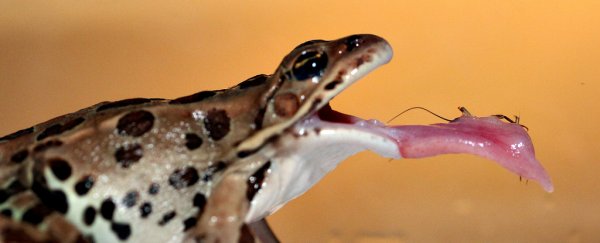If you've ever taken the time to watch a frog catch a bug mid-air with its tongue, you'll realise that they have some pretty unique hunting skills.
In fact, frogs stick and unstick their tongue to prey better than any commercial adhesive we've been able to create, and are capable of dragging insects back into their mouths at a peak acceleration of 12 gs - way more than anything astronauts experience.
But how is this possible? As Derek Muller explains in the latest episode of Sciencium, it's all thanks to some pretty incredible physics… and frog spit.

What's so remarkable about frogs' tongues is that, no matter what shape or sliminess their prey is, it never slides off their tongue, even when it's hurtling into their mouths at a mind-numbing 120 m/s2 (394 feet/second2).
In an attempt to figure out how this was possible, a team of researchers from the Georgia Institute of Technology used high-speed cameras to film a range of frog and toads pull insects into their mouths at crazy speeds - producing some of the awesome footage you see in the video above.
They then measured the softness of the frog and toad's tongues.
Interestingly, they found that frog tongues are particularly soft - 10 times softer than a human tongue, and comparable to the softness of rat brain tissue.
Why does softness matter? It's actually one of the important things that explains why frog tongues are so adhesive.
The second part of the puzzle is none other than frog spit.
The team discovered that frog spit is a type of non-Newtonian substance, called a two-phase viscoelastic fluid.
As the name applies, that means the fluid has high resistance to flow, just like honey, but it's also elastic, which means it deforms when a quick force is applied, but returns to its previous shape afterwards.
The aspect of the fluid depends on the amount of shear force acting on it. So under pressure, frog spit becomes runny, and when the pressure is lifted, it becomes sticky and viscous.
It's kind of like another non-Newtonian fluid, tomato sauce (or Ketchup), which is goopy and hard to budge when it's sitting at the bottom of a bottle, but if you apply pressure by tapping it, it becomes runny - and sometimes goes everywhere.
For frogs, this combination of a super-soft tongue and non-newtonian spit is the key to its stickiness.
When a frog's tongue hits its prey, it applies shear force that makes the frog's saliva runny, pouring into every bump and crevice of the insect.
When the pressure drops after the initial hit, the saliva returns to being thick, gooey, and elastic, helping it grip onto the prey hard enough to withstand the crazy g-forces of being dragged back into the frog's mouth.
Once the insect is safely inside the frog's mouth, the frog's eyes actually sink down to squeeze the saliva again, returning it to a liquid state so the prey is released and the frog can sallow it. Genius.
It's pretty fascinating science, but it turns out that humans might also be able to learn a lot from it, too.
We'll let Derek explain that in the video above, but we will add that we're pretty excited about the idea of using artificial frog spit to walk up walls. Thank you, nature.
